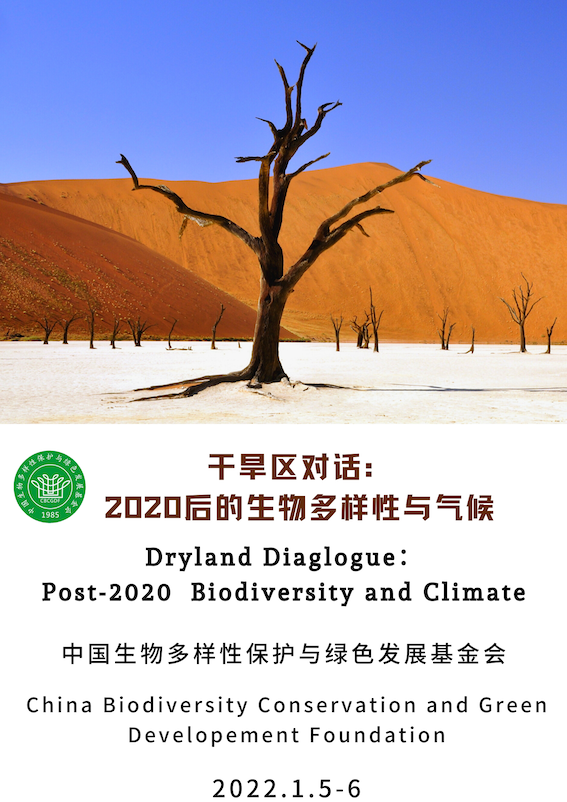2021/12/20
On January 5-6, CBCGDF will hold International Biodiversity Conference Summit 2022/1: Post-2020 Global Biodiversity Framework & Drylands Dialogue (GBF). To better understand the first draft of GBF and propose suggestions to CBD. Now CBCGDF is calling for signatures and suggestions of experts, academicians, and all who are interested.
Drylands Dialogue Statement Draft
Aware that drylands constitute about 41% of the Earth’s land surface and are home to over 38% of the world’s population. Drylands support one third of the Global Conservation Hotspot Areas and they are home to at least 28% of endangered species. Biodiversity conservation and sustainability development in drylands are crucial.
Recognizing that to achieve CBD’s 2030 Agenda for Sustainable Development and vision of “living in harmony with nature by 2050”, we believe it creates meaning to start the drylands dialogue, discussing biodiversity, sustainability, resilience of drylands under multiple environmental challenges. Consensus of building a shared future for drylands areas has been made, and willingness to promote this issue to the Post 2020 Global Biodiversity Framework has been reached.
We believe only cooperation and communication can bring drylands under the spotlight. To build a shard future for Drylands, promote it to be included in the Post 2020 Global Biodiversity Framework, realize the 2030 Agenda for Sustainable Development and vision of “living in harmony with nature by 2050”, we decide to:
1. All parties shall strengthen exchange and cooperation in the principle of inclusiveness, mutual-trust, equality, and mutual-benefit, enhance information exchange in science and education to build a shared future for Drylands together.
2.Working together to add biodiversity and climate of Drylands to the Post 2020 Global Biodiversity Framework.
3. Encourage more scientific institutions and international organizations to join us and realize the 2030 Agenda for Sustainable Development and vision of “living in harmony with nature by 2050” together for the wellbeing of all human beings.
We suggest
1. Add drylands in the Post-2020 Global Biodiversity Framework, for its biodiversity and sustainability create meaning for global environment.
2. For Post-2020 Global Biodiversity Framework Target 3
Ensure that at least 30 per cent globally of land areas and of sea areas, especially areas of particular importance for biodiversity and its contributions to people, are conserved through effectively and equitably managed, ecological representative and well-connected systems of protected areas and other effective area-based conservation measures and integrated into the wider landscapes and seascapes. Human-based Solutions be added. We think area-based conservation measures should take Human-based Solutions into consideration. Ecosystem in drylands is fragile and lacking development. Local people’s livelihoods matter as well. Human-based Solutions means every individual’s participation can protect the environment.
3. For Post-2020 Global Biodiversity Framework Target 4
Ensure active management actions to enable the recovery and conservation of species and the genetic diversity of wild and domesticated species, including through ex situ conservation, and effectively manage human-wildlife interactions to avoid or reduce human-wildlife conflict. Add the concept of Biodiversity Conservation in Our Neighborhood (BCON). In effectively manage human-wildlife interactions to avoid or reduce human-wildlife conflict, Biodiversity Conservation in Our Neighborhood (BCON) could be one of the feasible actions to introduce successful cases that human and animals living in harmony for the rest of the world to learn and adopt.
4. For Post-2020 Global Biodiversity Framework Target 14
Fully integrate biodiversity values into policies, regulations, planning, development processes, poverty reduction strategies, accounts, and assessments of environmental impacts at all levels of government and across all sectors of the economy, ensuring that all activities and financial flows are aligned with biodiversity values. Set a global standard to guide biodiversity assessment. Only by setting a global standard to guide biodiversity assessment can all goals be reached. Governments may issue economic policies that harm biodiversity. Our suggestion is to build Regional Comprehensive Assessment of Biodiversity (RCAB) to measure impacts of policies and programs on biodiversity. Also, RCAB could be used to make polices, programs and assess ESG of enterprises.
Contact:
Miss Xu: v90@cbcgdf.org
Miss Huang: v52@cbcgdf.org

Original Chinese article: https://mp.weixin.qq.com/s/MlkmakcCE-KzTph6rvdGew
Translator/Daisy
Contribution
https://www.paypal.me/CBCGDFChina
http://www.cbcgdf.org/English/ConfirmDonaTion/0.html